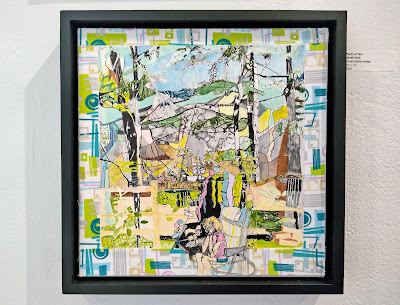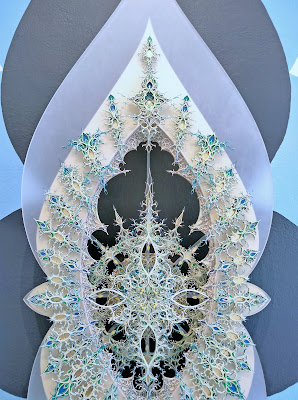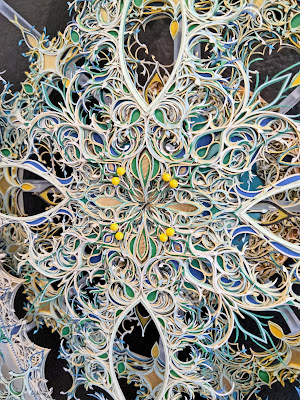Sunday, January 28, 2024
Now on the way home from Buffalo, a stop at the
Oneida Community Mansion House in Oneida, NY. This was the home of the most radical American utopian community, founded by John Humphrey Noyes in 1848, and voluntarily disbanded in 1880. Based on Perfectionism, a doctrine that believed one is not born with sin, the community fostered a work ethic, which sustained their enterprise even after they dissolved and continued as joint-stock corporation.
 |
In the South Garden, the NY State Champion
Juglans nigra/Eastern Black Walnut Tree
(planted c 1850-1851) |
 |
| The Victorian Knot Garden is also in the South Garden |
 |
Oneida Community Mansion House (1862-1914) was built
in phases using the architectural styles of the time |
 |
A bust (1907 cast of 1878 sculpture
by Frank Bergman) of the founder,
John Humphrey Noyes, an itinerant preacher
who was expelled from Yale Theological
Seminary because of his declaration that
he was perfect and free from sin |
 |
The community developed their own interpretation of
Christian symbols: the beehive represented group
cooperaton and industriousness, and the dove
implied the coming of heaven to earth |
 |
A model of the Oneida Communty with the Mansion House
(1862) in the foreground, the South Wing (1869) to the left,
the Tontine (1863-1864) in the rear that served as the communal
dining hall, kitchen, laundry, and workspace, and the New House
(1878) in back on the right was built to accommodate
members merging from the the Wallingford, CT branch |
 |
The largest cut-out puzzle in the world was developed by
the son of the founder, Pierrepont Noyes, and a grandson
by another son, Raymond, in 1927-1928 |
 |
Each piece in the puzzle was unique,
numbering about 10,000 |
 |
The courtyard has another NY State Champion
Tree, a Liriodendron tulipifera/Tulip Tree |
 |
The women wore a short dress with pants,
and no corset, to better participate in various
labors and recreation, and supposedly to
provide them autonomy and equality |
 |
Nursery kitchen in the children's wing; the
community believed in "complex marriage,"
where every community member was
also a member of the marriage, and children
were "procreated" by pairings of the
most highly spiritual members |
As well as planned procreative intercourse, amative intercourse was encouraged for pleasure. Yet men had to practice male continence to avoid pregnancy. Thus birth control was the man's responsibility, to
prevent unnecessary pain and suffering of pregnancy for women. But amative intercourse should not lead to a relationship.
 |
| Nursery kitchen |
 |
Stairway woodwork leads to private
apartments created from the Oneida
Community living spaces |
 |
One Community member, Jessie Kinsley, began creating
art through rug braiding; this is Memory Hither Come (1928),
which was commissioned for the Oneida Community Ltd
boardroom and features major Oneida properties in the
United States and Europe, surrounded by images from
the town of Oneida and the Mansion House |
 |
Street Scene (1938) was the last braiding
art done by Jessie Kinsley |
 |
| Street Scene detail |
 |
Study for Street Scene (1913) was done
in Devonshire, England, when Kinsley
traveled through Europe for six months |
 |
Later Kinsley began incorporating writing
in the braided works |
 |
| Oneida Community Library |
 |
The public library and lounge is adjacent to the section
of the Mansion House that is a Bed & Breakfast |
 |
| Alice in Wonderland-inspired yarn dolls (by Christine Allen) |
 |
We peeked into a small B&B room,
with a Keurig coffeemaker ... |
 |
| ... and a flatscreen television ... |
 |
| ... plus a private bathroom |
 |
| Upstairs was an extensive Victorian curiosity cabinet |
 |
The industry room showcased products made by
the Community, primarily the silverware that led to
the joint-stock corporation in 1881 and Oneida Ltd
in 1935; the company was very successful until the
events of September 11, 2001 affected the hospitality
industry; now Oneida focuses on sales and marketing
and outsources manufacturing to Asia |
 |
| Oneida Newhouse [Animal] Trap (c 1900) |
 |
| Carpet Bag (c 1860s) |
 |
| Machine-twisted silk thread (c 1870s) |
 |
Display showing the production sequence of a spoon,
and examples of Oneida silverware styles |
 |
| The Great Hall could hold all the Community members |
 |
| The stage in the Great Hall |
 |
Upper Sitting Room was the social area
surrounded by individual sleeping rooms |
 |
The sleeping room was meant for sleeping, and privacy
during amative intercourse, but not sleeping together |
 |
The Summer House (1864, originally
with a thatched roof) |

















































